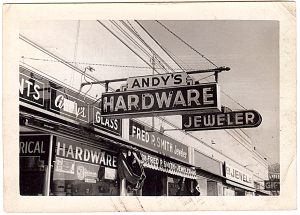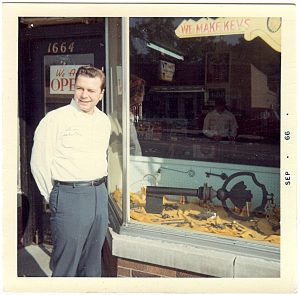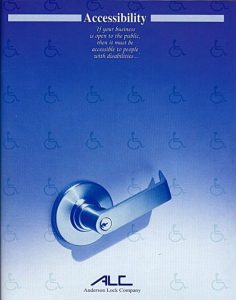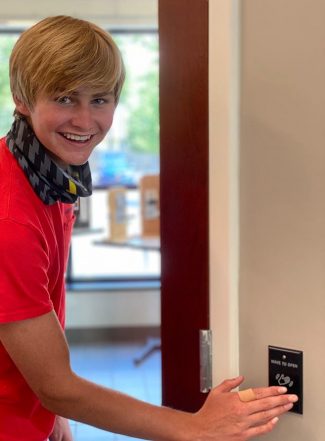The Americans with Disabilities Act: 30 Years Before & 30 Years After

Gene founded his company in a corner of his parents’ store.
In 1960, Gene Anderson’s entrepreneurial vision led him to incorporate his fledgling one-man locksmith business, which had been operating in a corner of his parents’ hardware store, into Anderson Locksmiths, LLC. Before long, his parents sold Andy’s Ace Hardware to join Gene in a new location. A notebook, filled with A.O. (Andy) Anderson’s memories, recalled having had some hesitation about the sale.
However, the proud father affirmed “the unbelievable foresight and vision Gene exemplified.”

Gene Anderson at the first standalone location for his Anderson Locksmiths, LLC
Gene moved his company to 1664 Oakton Street, in Des Plaines. In 1964 or ’65, a Yale Lock representative asked him to become a distributor for Yale door closers, locks and security products. He also represented Lockwood, Ilco and other industry manufacturers. The thriving security business moved again in 1967, to 1539 Oakton Street. The then-new Kennedy Expressway, connecting Chicago and O’Hare International Airport, led to increased demand for Anderson Lock’s Master Key Systems, and commercial security door hardware products. During the 70’s, Gene became a distributor of Schlage, LCN and Von Duprin products. He dispatched locksmiths daily to install door knobs, deadbolts, door closers and exit devices.
Thirty Years Later…
In 1990, Anderson Lock had moved to its third location, and had grown to 30 employees. On July 26 of that year, President H.W. Bush signed the Americans with Disabilities Act, which reshaped the way designers and the public have come to think about civil rights and the built world. There was an “accessibility standard” at that time, but the ADA really focused the door and hardware industry on how our products affect people with disabilities.
Gene noted that his warehouse was filled with door security products that met the new handicap codes. He further observed that many of his customers were asking about the new law and its implications for buildings that served the public. So, although his staff was in the midst of creating a full line print catalog, he researched portions of the ADA guidelines pertaining to public accommodations and commercial facilities that now were being required to be made “readily accessible to, and usable by, individuals with disabilities, including those who use wheelchairs.”
Then, in his words, “It seemed only natural that we should interrupt our catalog schedule a bit to get this information to you (his customers) as quickly as possible.”

Anderson Lock’s Accessibility Catalog featured many manufacturers’ levers
Thus, the Anderson Lock Company’s ‘Accessibility’ catalog was published in early 1992. The blue cover featured a lever lock, a strong symbol of how door hardware on both new and existing facilities was being altered, because “accessible doors should have hardware that is shaped so that it is easy to grasp with one hand and does not require tight grasping or pinching or twisting of the wrist to operate.”
Lever-operated mechanisms, push type mechanisms, and U-shaped handles are the acceptable designs of the ADAAG.
Anderson Lock techs replaced thousands of door knobs with lever locks in schools, office buildings and healthcare facilities in the 1990’s.
Another 30 Years Later…
In 2020, Gene is retired, and the company, led by his daughter, Cortney, has grown to 103 employees at two locations. Thirty service and delivery vehicles are dispatched daily throughout Chicagoland.
Cortney’s vision for becoming a total opening supplier was realized with the creation of a Door Division, managed by her husband, Devin Wascher. Her foresight to focus on electronic access control systems made Anderson Lock an industry leader for commercial locksmith and door security solutions.
Today’s Americans take for granted the ways the ADA transformed everyday life for people with disabilities. The 1990 legislation inspired architects, and the general public, to keep broadening the way they define accessibility. More accessible design creates a better environment for everyone. The now-commonplace curb ramps make daily life easier for cyclists, travelers pulling wheeled bags, parents pushing strollers—not just for those with physical impairments.
By removing barriers, inspiring advances in accessible design, and asking architects to focus even more on the diversity of human experience, the act changed the way we think about, and build, public spaces.

Cortney and Devin’s son, Will, waves to open a door at Anderson Lock.
Some of the designs, inspired by the ADA, like pushbuttons to open doors, are now being upgraded to reduce the spread of germs with “wave to open” touchless door hardware. Electric latch retraction, arm and foot pulls, and push/pull door trims will soon be commonplace in public buildings.
30 Years from Now…
In 2050, I predict that Anderson Lock will be led by a new generation of family members with vision and foresight. The company will employ many more people, in more locations, and will dispatch skilled technicians who will wonder why it took passage of a law to make our built environment accessible to all people.
By Kathi Bradbury Frelk



